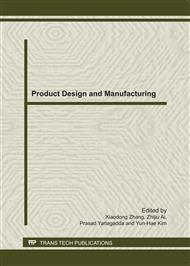p.656
p.661
p.665
p.670
p.677
p.685
p.689
p.697
p.701
Electronic Tension Control of High-Speed and Active Sending Line Based on Fuzzy PID Control
Abstract:
In the case of small diameter( 10000 r/min)winding, high-speed initiative electronic tension control for sending line was designed to solve the problem that the winding motor speed changes at the start and down state and increasing the size of the coil wound level lead to tension fluctuation. The structure, working principle and the factors that affect the tension fluctuation were discussed in detail. The transfer function of this system was deduced, and the Fuzzy PID control algorithm was also introduced to the system. The model of the Fuzzy PID control algorithm and the conventional PID control algorithm were established using MATLAB/SIMULINK tool, The simulation results show that the fuzzy PID control is better than the conventional PID control in improving the dynamic response of the tension controller, furthermore, the control precision and in terms of robustness is showed.
Info:
Periodical:
Pages:
677-684
Citation:
Online since:
September 2011
Authors:
Price:
Сopyright:
© 2011 Trans Tech Publications Ltd. All Rights Reserved
Share:
Citation:


